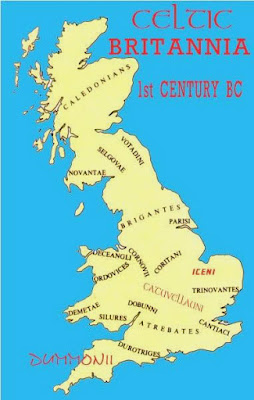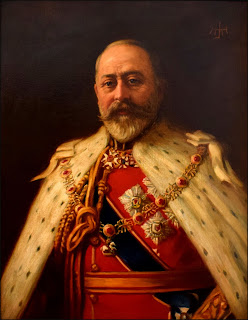Vikings and the beginning of Norman Britain / Middle Ages
When Denmark invaded England in 1013, his
family was exiled in Normandy. He kept exiled until 1041, year in which he took
part in the court of his brother Harthacnut, who died on his own wedding
because he had too much alcohol in 1042. After the death of his brother, Edward
became the new king of England.
During his reign, he had to face a one-year
crisis due to ecclesiastic problems (the monks of Canterbury chose a Godwin’s
relative as Archbishop of Canterbury in 1051, but Edward rejected him and
appointed Robert of Jumièges.
After that, Archbishop Robert accused Godwin of
plotting against the king. But, as any side was willing to fight each other,
Godwin and his sons run away and headed to Flanders and Ireland.
The succession
The succession
There are many theories and discrepancies about
the succession, and many historians disagree with each other, but this one is
the most supported and convincible hypothesis:
The son of Edmund Ironside, Edgard, was the favourite one to come after Edward (and was given the throne worthy designation), but
some years later, by his deathbed, Edward promised the throne to Harold Godwin,
and the promise he made to Edgard had been called off. Therefore, Harold Godwin
became King Harold II of England in January 1066, and was the last Anglo-Saxon
king on England.
WILLIAM DUKE OF NORMANDY
He came to be knight in 1042, when he still was
an adolescent. He took part in political issues, and by 1064 he had already
conquered two provinces: Brittanie and Maine.
After that, was involved in a fight against the
current king Harold Godwin (because Edward The Confessor first promised the
throne to William but on his deathbed, Edward promised the throne to Herald).
 The conflict was solved out in the Battle of
Hastings in October 14th, 1066. William defeated Harold and became
the new King of England on the 25th of December.
The conflict was solved out in the Battle of
Hastings in October 14th, 1066. William defeated Harold and became
the new King of England on the 25th of December.
In the next 5 years, a lot of revolts took
place, and William took advantage of them to confiscate the Land and made it
his private property, so it was distributed to his Norman adepts to impose
their unique Feudal system.
Nevertheless, he had much influence on the
evolution of English language and was responsible for making Britain the most
powerful nation in Europe.
BATTLE OF HASTINGS
The Battle of Hastings happened on 14th October 1066. It was a confrontation between the Norman army leaded by William, the Duke of Normandy, and the army of the Anglo-Saxon King Harold Godwinson.
Antecedents
Two weeks before the battle, William invaded England and clamed his right to the throne. According to some historians, William visited his cousin Edward The Confessor in 1051 and he promised him the throne. However, on his deathbed, Edward promised the throne to Harold Godwin.
When Edward died in 1066, Harold was proclaimed
king and, soon afterwards, William disputed his claim.
On September 28th, 1066, William and
his army arrived in Britain. On October 13th, Harold arrived near
Hastings with his army, and the next day the battle started.
William won the battle and on Christmas Day, 1066, he
was crowned the first Norman king of England, and the Anglo-Saxon phase of
English history finished. French became the language of the king’s court and
gradually was turned into modern English.
William I was an effective king of England and, after
the death of William I in 1087, his son, William Rufus, became William II, the
second Norman king of England.
Middle Ages
- William I: Known as William the Conqueror or William the Bastard. Was born in 1028 and died in 1087. He was the first king of England, after he conquered it. He had many problems to stablish his power in Normandy, but when he did, he started to conquer England. He was son of Robert I, who wasn’t married.
 Henry II: (Henry II Plantagenet) King of England that was coronated on the
19th of December of 1154. He was born in Le Mans (France). First son
of Godofred V of Anjou and his wife, the emperatriz Matilde, daughter of Henry
II. First king of England from the Plantagenet dinasty.
Henry II: (Henry II Plantagenet) King of England that was coronated on the
19th of December of 1154. He was born in Le Mans (France). First son
of Godofred V of Anjou and his wife, the emperatriz Matilde, daughter of Henry
II. First king of England from the Plantagenet dinasty.
Middle Ages
- William I: Known as William the Conqueror or William the Bastard. Was born in 1028 and died in 1087. He was the first king of England, after he conquered it. He had many problems to stablish his power in Normandy, but when he did, he started to conquer England. He was son of Robert I, who wasn’t married.
- Feuday system: It was a way to order the different people in order to it’s power.
Feudal system was used in France by the Normans since they stablished there.
The way it was organized was the next: on top, with total power, was the King, who owned everything: lands,
properties, etc. Just under him were the Barons,
who were chosen by the king. Those barons, who got some lands of the King,
picked up some knights, that got
some lands and protection. Knights picked up some villeins to work in this lands, so they were able to eat and earn
some money.
 Henry II: (Henry II Plantagenet) King of England that was coronated on the
19th of December of 1154. He was born in Le Mans (France). First son
of Godofred V of Anjou and his wife, the emperatriz Matilde, daughter of Henry
II. First king of England from the Plantagenet dinasty.
Henry II: (Henry II Plantagenet) King of England that was coronated on the
19th of December of 1154. He was born in Le Mans (France). First son
of Godofred V of Anjou and his wife, the emperatriz Matilde, daughter of Henry
II. First king of England from the Plantagenet dinasty.
At his time as king of England, he tried to establish
the royal privileges that were when his grandfather Henry I was the King.
He had 8 children with Leonor, his wife. As the sons
started to grow up, the tensions about the inheritance of the throne.
Finally, after some revelations and really high tensions,
Henry the Young became the king (he was the second child of Henry II).
Blackdeath: Was en epidemic that affected England and specially London in 1665. It killed almost 100.000 people and 1/5 part of London. This epidemic was trasnmitted by the rats fleas and it’s remembered as the “Big Plague” because it was one of the last big plages at Europe.
It was remembered to one that occurred in Europe in 1350, but this one affected to much less people.
It was thought from the beginning that the plague was introduced to England by the boats that came from Holand with cotton. In Holand the plague was affecting since 1654, and added to this, the ports of the time were not really hygienic.
That same year the plague didn’t cause many deaths because of the cold weather that was at the moment and the difficulty to the plague to be transmitted, but, a year later, because of the high temperatures in summer, the plague started to expand.
The first case of plague given in England was Margaret Porteus, the 12 of Aril 1665.
Richard I (lionheart): He was king of England since the 6th of July 1189 until his death. He was Duke of Normandy, Gascony and Arquitaine as King of England.
Richard I (lionheart): He was king of England since the 6th of July 1189 until his death. He was Duke of Normandy, Gascony and Arquitaine as King of England.
He was the 3rd of 5 sons Henry II had. The name “lionheart” was given to him because of his reputation as a great military and warrior.
When he was coronated, he excluded the jews fom the court and didn’t let them to witness his coronation. From this moment, in London happened a massacre, were all he jews were killed and burned alive; their houses were destroyed, etc.
- King John (24 December 1166 – 19 October 1216), also known as John Lackland, was king of England from 6 April 1199 until his death in 1216.

King Richard the Lionheart was his older brother, and his predecessor. John earned himself the nickname “Without Land” due to his lack of inheritance because he was the minor of the brothers and for loosing the territories in France; he was also nicknamed as “Soft Sword” because his military ineptitude.
- King John (24 December 1166 – 19 October 1216), also known as John Lackland, was king of England from 6 April 1199 until his death in 1216.

King Richard the Lionheart was his older brother, and his predecessor. John earned himself the nickname “Without Land” due to his lack of inheritance because he was the minor of the brothers and for loosing the territories in France; he was also nicknamed as “Soft Sword” because his military ineptitude.
His nine year old son was his successor and became Richard III of England (1216-1272)
- Magna Carta was document which function was a peace treaty; the 63 articles of the Magna Carta ensure feudal rights to the aristocracy against the power of the king.
The power of the king was limited by a council or congress.
It was written after tense and complicated meetings in Runnymede. After a lot of fights between nobles, the Magna Carta was finally sanctioned by King John I in London on June 15, 1215. The Norman nobles oppressed the Anglo-Saxons and these rebelled against the former.




Comentarios
Publicar un comentario